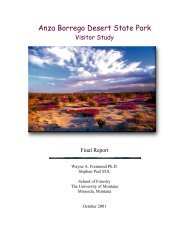Final Mitigated Negative Declaration and Response to Comments
Final Mitigated Negative Declaration and Response to Comments
Final Mitigated Negative Declaration and Response to Comments
You also want an ePaper? Increase the reach of your titles
YUMPU automatically turns print PDFs into web optimized ePapers that Google loves.
the edges of the rubber sheets for underwater securement as well as for removal after<br />
the application period is complete. Once the preparation stage is complete, the rubber<br />
barrier material will be transferred <strong>to</strong> a barge or boat <strong>and</strong> delivered <strong>to</strong> the field site.<br />
Placement of the rubber material at the field site<br />
The rubber barriers <strong>and</strong> associated weights (rebar rods <strong>and</strong>/or chain link) for the rubber<br />
sheets will be lowered <strong>to</strong> the lake bot<strong>to</strong>m from the side of the barge using a winch or<br />
backhoe. The materials will be lined up along the edge of the delineated field site.<br />
Float bags may be used <strong>to</strong> secure the rubber bot<strong>to</strong>m barrier material underwater <strong>to</strong><br />
reduce the weight of each rubber barrier roll. The rubber barriers will be rolled out<br />
underwater by divers. It is estimated that approximately 6 divers per day for 20 days (3<br />
hours each in water, 4 in the water at any one time) is required for this task. Shorter<br />
dives <strong>to</strong> schedule work <strong>to</strong> avoid high visi<strong>to</strong>r use periods or for other reasons would<br />
increase the number of days required <strong>to</strong> complete work. After the rubber barriers are<br />
rolled out, the edges <strong>and</strong> seams of the rubber treatment site will be covered with rebar<br />
<strong>and</strong> other weights (no s<strong>and</strong> bags will be used) <strong>and</strong> staked down where necessary; it is<br />
estimated that this task will take 10 days (<strong>to</strong>tal of 6 divers, 3 hours each in water, 4<br />
people in water at any one time).<br />
Design <strong>and</strong> testing of alternative treatment methods<br />
Benthic barrier treatment has been shown <strong>to</strong> be a very effective method <strong>to</strong> kill AC in<br />
Lake Tahoe, but there are some situations where flow through the substrate underneath<br />
the barriers allows clams <strong>to</strong> survive in a highly stressed state. In these limited<br />
situations, alternative methods <strong>to</strong> supplement benthic barrier treatment will be required<br />
<strong>to</strong> control AC. One alternative tested will be insertion of supplemental material such as<br />
straw (organic matter) under the barriers <strong>to</strong> determine whether the supplements<br />
adequately decrease dissolved oxygen under the mats <strong>to</strong> increase the effectiveness of<br />
the benthic barriers where there is some subsurface flow. Suction removal of AC has<br />
been tested in Lake Tahoe but the method was determined <strong>to</strong> be more costly than the<br />
benthic barrier treatment method. We may engineer <strong>and</strong> test new suction removal<br />
technology <strong>to</strong> attempt <strong>to</strong> bring the cost down <strong>and</strong> this method may be used <strong>to</strong><br />
supplement benthic barrier treatment in Emerald Bay. Additionally, a literature review<br />
<strong>and</strong> pilot testing of additional methods such as freezing clams in place in the substrate<br />
may be employed depending on treatment cost. All treatment methods will be vetted<br />
through the permitting agencies <strong>and</strong> included in all permit applications.<br />
Removal <strong>and</strong> decontamination of rubber material<br />
After greater than 6 months but less than 20 24 months, the rubber bot<strong>to</strong>m barriers <strong>and</strong><br />
all associated materials will be removed from the lake bot<strong>to</strong>m. The initial step in this<br />
process is <strong>to</strong> remove all weights from the field treatment site. It is estimated this task<br />
will take 20 days (<strong>to</strong>tal of 6 divers, 3 hours each in water, 4 in water at any one time).<br />
Shorter dives <strong>to</strong> schedule work <strong>to</strong> avoid high visi<strong>to</strong>r use periods or for other reasons<br />
would increase the number of days required <strong>to</strong> complete work. The next step is the<br />
removal of each rubber barrier sheet. A diver will attach the edges of each sheet <strong>to</strong> a<br />
rolling system that will be operated from the barge. The rolling system will draw the<br />
sheet up as it rolls it up from the bot<strong>to</strong>m of the lake <strong>and</strong> will require no diver labor other<br />
Asian Clam Control Project IS/MND<br />
Emerald Bay State Park<br />
California Department of Parks <strong>and</strong> Recreation<br />
11
















